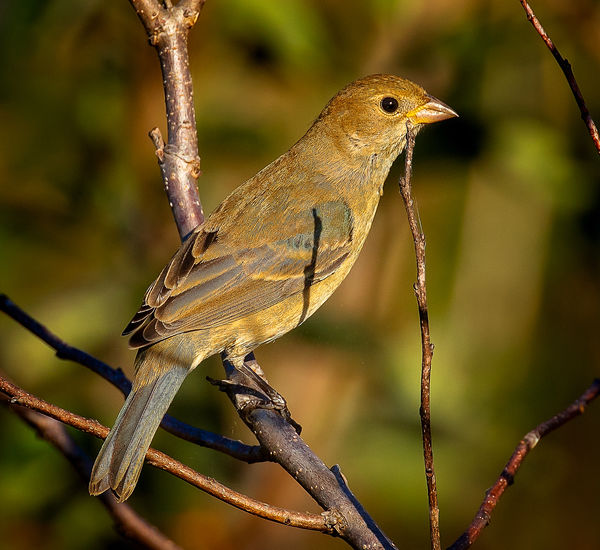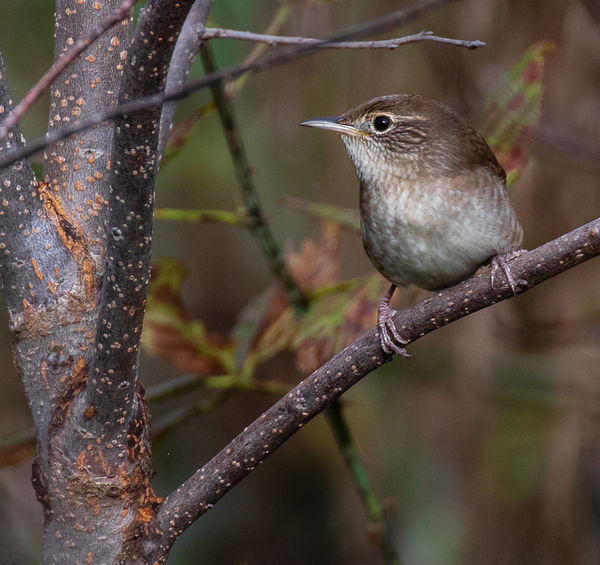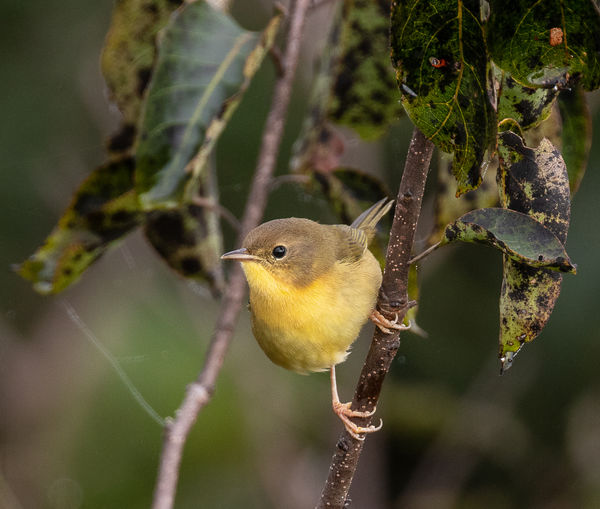Check out Travel Photography - Tips and More section of our forum.
Posts for: MikeBl
Oct 2, 2018 06:27:23 #
Rose-breasted Grosbeak - female
(Pheucticus ludovicianus)
W. Kentucky, USA - 9/30/2018
1/400 sec - f/8.0 - ISO 400
Interesting Tidbit: Rose-breasted grosbeak inhabits deciduous and mixed forests,
areas near the streams and marshes. It can be also found in the orchards, parks
and gardens. Rose-breasted grosbeaks are threatened by intense deforestation.
Luckily, wild population of these birds is still large and stable. ~Wildlife Journal~
(Pheucticus ludovicianus)
W. Kentucky, USA - 9/30/2018
1/400 sec - f/8.0 - ISO 400
Interesting Tidbit: Rose-breasted grosbeak inhabits deciduous and mixed forests,
areas near the streams and marshes. It can be also found in the orchards, parks
and gardens. Rose-breasted grosbeaks are threatened by intense deforestation.
Luckily, wild population of these birds is still large and stable. ~Wildlife Journal~
Oct 1, 2018 15:08:04 #
vonzip wrote:
Nice sharp photo. I would of thought of that being a yellow warbler and gone about my merry way. Thanks Mike for sharing. vz
When unsure, I usually go to the experts on several FB Bird ID pages to get an ID or confirmation.
Such was the case with this bird.
Oct 1, 2018 12:12:50 #
Philadelphia vireo (Vireo philadelphicus)
W. Kentucky, USA - 9/30/2018
1/400 - f/8.0 - ISO 400
Interesting Tidbit: The Philadelphia Vireo is unlikely to visit Philadelphia, except during
its migration. They can coexist with Red-eyed vireos because they modify their behavior
either to exclude the Red-eyed Vireo from its territory or to avoid it by foraging in areas
seldom used by that species. A group of vireos are collectively known as a "call" of vireos.
~What Bird~
W. Kentucky, USA - 9/30/2018
1/400 - f/8.0 - ISO 400
Interesting Tidbit: The Philadelphia Vireo is unlikely to visit Philadelphia, except during
its migration. They can coexist with Red-eyed vireos because they modify their behavior
either to exclude the Red-eyed Vireo from its territory or to avoid it by foraging in areas
seldom used by that species. A group of vireos are collectively known as a "call" of vireos.
~What Bird~
Check out True Macro-Photography Forum section of our forum.
Oct 1, 2018 05:55:16 #
Brown Thrasher (Toxostoma rufum)
W. Kentucky, USA - 9/29/2018
1/100 sec - f/10 - ISO 100
Interesting Tidbit: The brown thrasher has an amazing repertoire of songs, one
of the largest of any North American bird. Its songs generally consist of a loud,
long series of variable phrases, with each phrase usually repeated twice and
punctuated by a pause. It also occasionally mimics the calls of other birds as part
of its repertoire. ~Wildscreen Arkive~
W. Kentucky, USA - 9/29/2018
1/100 sec - f/10 - ISO 100
Interesting Tidbit: The brown thrasher has an amazing repertoire of songs, one
of the largest of any North American bird. Its songs generally consist of a loud,
long series of variable phrases, with each phrase usually repeated twice and
punctuated by a pause. It also occasionally mimics the calls of other birds as part
of its repertoire. ~Wildscreen Arkive~
Sep 30, 2018 13:01:09 #
Indigo Bunting - female (Passerina cyanea)
W. Kentucky, USA - 9/29/2018
1/400 sec - f/9.0 - ISO 400
Interesting Tidbit: The dull grey-brown plumage of the female indigo bunting is similar
to that of the non-breeding male. The female has faint dark streaking on its breast and
belly, a white throat, buff underparts and wing-bars, and variable amounts of blue on its
shoulders, rump and tail. The bill of the female indigo bunting is short, thick and conical,
while that of the male is bi-colored, with a black upper mandible and a silver lower mandible.
W. Kentucky, USA - 9/29/2018
1/400 sec - f/9.0 - ISO 400
Interesting Tidbit: The dull grey-brown plumage of the female indigo bunting is similar
to that of the non-breeding male. The female has faint dark streaking on its breast and
belly, a white throat, buff underparts and wing-bars, and variable amounts of blue on its
shoulders, rump and tail. The bill of the female indigo bunting is short, thick and conical,
while that of the male is bi-colored, with a black upper mandible and a silver lower mandible.
Sep 30, 2018 05:40:02 #
House Wren (Troglodytes aedon)
W. Kentucky, USA - 9/28/2018
1/400 sec - f/8.0 - ISO 640
Interesting Tidbit: As the season progresses, House Wren nests can become infested
with mites and other parasites that feed on the wren nestlings. Perhaps to fight this
problem, wrens often add spider egg sacs into the materials they build their nests from.
In lab studies, once the spiders hatched, they helped the wrens by devouring the nest
parasites. ~Nest Watch~
W. Kentucky, USA - 9/28/2018
1/400 sec - f/8.0 - ISO 640
Interesting Tidbit: As the season progresses, House Wren nests can become infested
with mites and other parasites that feed on the wren nestlings. Perhaps to fight this
problem, wrens often add spider egg sacs into the materials they build their nests from.
In lab studies, once the spiders hatched, they helped the wrens by devouring the nest
parasites. ~Nest Watch~
Sep 29, 2018 06:44:04 #
Common yellowthroat warbler - female
(Geothlypis tricha)
W. Kentucky, USA - 9/28/2018
1/400 sec - f/8.0 - ISO 640
Interesting Tidbit: Females and young yellowthroats do not have a mask. Yellowthroats live in grassy
marshes, or in wet meadows or thickets. They nest on or near the ground, usually in a clump of grass,
cattails, reeds, bulrushes, weeds or low shrub. Sometimes they nest in a willow tree or inside a Skunk Cabbage.
~The Website for Everything~
(Geothlypis tricha)
W. Kentucky, USA - 9/28/2018
1/400 sec - f/8.0 - ISO 640
Interesting Tidbit: Females and young yellowthroats do not have a mask. Yellowthroats live in grassy
marshes, or in wet meadows or thickets. They nest on or near the ground, usually in a clump of grass,
cattails, reeds, bulrushes, weeds or low shrub. Sometimes they nest in a willow tree or inside a Skunk Cabbage.
~The Website for Everything~
Sep 29, 2018 06:21:27 #
Common yellowthroat warbler - male
(Geothlypis tricha)
W. Kentucky, USA - 9/28/2018
1/400 sec - f/8.0 - ISO 1250
Interesting Tidbit: They are apparently monogamous within a breeding season and only infrequently
will males be seen with two mates in their territory. Females, however, show no fidelity to their mates
and often attract other males with their calls. A group of warblers has many collective nouns, including
a "bouquet", "confusion", "fall", and "wrench" of warblers.
~What Bird~
(Geothlypis tricha)
W. Kentucky, USA - 9/28/2018
1/400 sec - f/8.0 - ISO 1250
Interesting Tidbit: They are apparently monogamous within a breeding season and only infrequently
will males be seen with two mates in their territory. Females, however, show no fidelity to their mates
and often attract other males with their calls. A group of warblers has many collective nouns, including
a "bouquet", "confusion", "fall", and "wrench" of warblers.
~What Bird~
Sep 28, 2018 14:13:27 #
*Correction*
House Wren (Troglodytes aedon)
W. Kentucky, USA - 9/28/2018
1/400 sec - f/8.0 - ISO 640
Interesting Tidbit: House Wrens are fiercely territorial, they have been known to destroy
bluebird and other cavity nester's eggs by piercing them, and then often removing the
eggs from the nest. A group of wrens has many collective nouns, including a "chime",
"flight", "flock", and "herd" of wrens.
~What Bird~
House Wren (Troglodytes aedon)
W. Kentucky, USA - 9/28/2018
1/400 sec - f/8.0 - ISO 640
Interesting Tidbit: House Wrens are fiercely territorial, they have been known to destroy
bluebird and other cavity nester's eggs by piercing them, and then often removing the
eggs from the nest. A group of wrens has many collective nouns, including a "chime",
"flight", "flock", and "herd" of wrens.
~What Bird~
Sep 28, 2018 06:33:59 #
I *FINALLY* got a quick glimpse of a Magnolia warber, signaling the arrival
of the fall migration! This tiny beauty was hiding from the rain, deep in the
willow leaves.
Magnolia Warbler (Setophaga magnolia)
W. Kentucky, USA - 9/27/2018
1/200 sec - f/8.0 - ISO 160
Interesting Tidbit: The Magnolia Warbler was named in 1810 by Alexander Wilson,
who collected a specimen from a magnolia tree in Mississippi. He used the English
name "Black-and-yellow Warbler" and used "magnolia" for the Latin species name,
which became the common name over time. A group of magnolia warblers are
collectively known as a "corsage" of warblers. ~What Bird~
of the fall migration! This tiny beauty was hiding from the rain, deep in the
willow leaves.
Magnolia Warbler (Setophaga magnolia)
W. Kentucky, USA - 9/27/2018
1/200 sec - f/8.0 - ISO 160
Interesting Tidbit: The Magnolia Warbler was named in 1810 by Alexander Wilson,
who collected a specimen from a magnolia tree in Mississippi. He used the English
name "Black-and-yellow Warbler" and used "magnolia" for the Latin species name,
which became the common name over time. A group of magnolia warblers are
collectively known as a "corsage" of warblers. ~What Bird~
Sep 27, 2018 16:02:03 #
Bumblebee (Bombus)
W. Kentucky, USA - 9/24/2018
1/400 - f/8.0 - ISO 1600
Interesting Tidbit: Only the fat queen bee survives winter hibernation, and shes left to create a
colony by herself. Sperm stored up from mating the previous summer survives in her ovaries,
ready to fertilize her eggs once she finally finds a nesting place. By the end of the summer, when
shes a little over a year old, the queen and all her worker bees die, to be replaced by her daughters.
~Mental Floss~
W. Kentucky, USA - 9/24/2018
1/400 - f/8.0 - ISO 1600
Interesting Tidbit: Only the fat queen bee survives winter hibernation, and shes left to create a
colony by herself. Sperm stored up from mating the previous summer survives in her ovaries,
ready to fertilize her eggs once she finally finds a nesting place. By the end of the summer, when
shes a little over a year old, the queen and all her worker bees die, to be replaced by her daughters.
~Mental Floss~
Check out Drone Video and Photography Forum section of our forum.
Sep 27, 2018 10:56:29 #
CHG_CANON wrote:
Wonderful! If you crop in again on just her face (chin whiskers to ears at 100%), you'll have another interesting portrait with the great details of her eyes.
Yes, I did that, just to see the beautiful eyes and lashes.
Sep 27, 2018 06:04:35 #
I have often said I never feel alone in the wild. I am never far from the watchful eyes of wildlife.
This young doe seemed extremely interested in what I was doing. (Notice the fawn spots still
showing on her flank and belly.)
Interesting Tidbit: According to the Washington Department of Fish & Wildlife, most deer -- does
and bucks alike -- don't live more than five years, and very few live more than 10 years. A doe
reproduces regularly throughout her life, though. She can start reproducing at the age of 1 and
will continue giving birth to one or several fawns once a year. ~Animals.mom~
This young doe seemed extremely interested in what I was doing. (Notice the fawn spots still
showing on her flank and belly.)
Interesting Tidbit: According to the Washington Department of Fish & Wildlife, most deer -- does
and bucks alike -- don't live more than five years, and very few live more than 10 years. A doe
reproduces regularly throughout her life, though. She can start reproducing at the age of 1 and
will continue giving birth to one or several fawns once a year. ~Animals.mom~
Sep 26, 2018 16:58:37 #
Red-headed woodpecker - immature
(Melanerpes erythrocephalus)
W. Kentucky, USA - 9/22/2018
1/100 - f/8.0 - ISO 400
Interesting Tidbit: The red-headed woodpecker is a small or medium-sized woodpecker
from temperate North America. Their breeding habitat is open country across southern
Canada and the eastern-central United States. It is rated as near threatened on the
International Union for Conservation of Nature's Red List of Endangered species. ~Wikipedia~
(Melanerpes erythrocephalus)
W. Kentucky, USA - 9/22/2018
1/100 - f/8.0 - ISO 400
Interesting Tidbit: The red-headed woodpecker is a small or medium-sized woodpecker
from temperate North America. Their breeding habitat is open country across southern
Canada and the eastern-central United States. It is rated as near threatened on the
International Union for Conservation of Nature's Red List of Endangered species. ~Wikipedia~
Sep 26, 2018 16:23:35 #
JeffDavidson wrote:
Nice shot. I wish that little out of focus twig wasn't there. Thanks for the commentary. Very interesting.
I wonder how many times I have said that? Sadly, when you photograph birds in trees or bushes, it's part of the game.
I am at the point now where they don't bother me nearly as much. I am an amateur and my images are not, obviously, professionally edited.
Check out Street Photography section of our forum.












